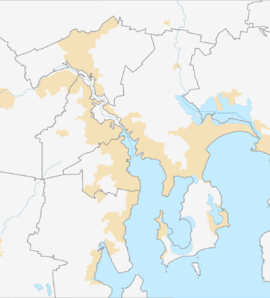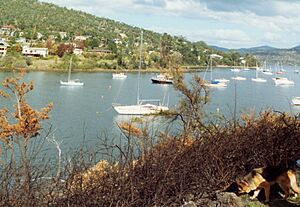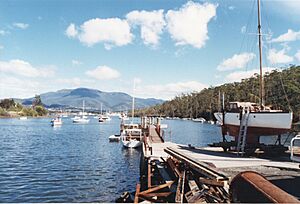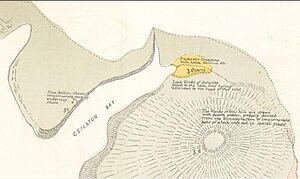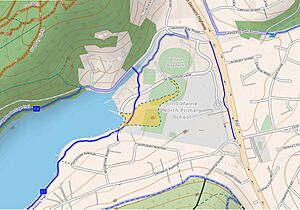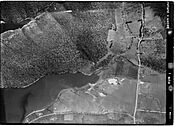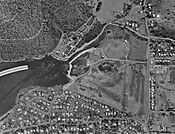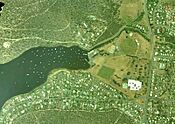Geilston Bay, Tasmania facts for kids
Quick facts for kids Geilston BayHobart, Tasmania |
|||||||||||||||
|---|---|---|---|---|---|---|---|---|---|---|---|---|---|---|---|
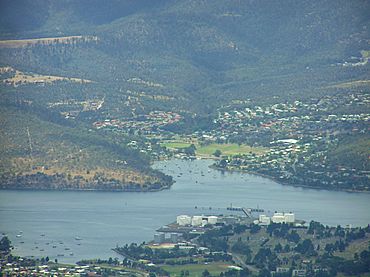
View from Mount Wellington
|
|||||||||||||||
| Postcode(s) | 7015 | ||||||||||||||
| LGA(s) | City of Clarence | ||||||||||||||
| Federal Division(s) | Franklin | ||||||||||||||
|
|||||||||||||||
Geilston Bay is a quiet suburb located on the eastern side of the Derwent River in Hobart, Tasmania. It's nestled between Risdon Vale, Shag Bay, and Lindisfarne. The area gets its name from an early land owner, Andrew Geils, who bought land here around 1812. For a long time, it was also known as "Limekiln Bay" because of old lime kilns that used to operate there.
Geilston Bay is also famous for a very important fossil discovery. Scientists found ancient mammal fossils here from millions of years ago! These fossils are now kept at the British Museum in London.
| Top - 0-9 A B C D E F G H I J K L M N O P Q R S T U V W X Y Z |
Discovering Geilston Bay's Past
Early Aboriginal Life
Long before Europeans arrived, the land around Geilston Bay was home to the Mumirimina people. They were a semi-nomadic group who lived in the Oyster Bay region for thousands of years. You can still find signs of their past, like shell middens (piles of shells from their meals) and an old rock shelter between Geilston Bay and Shag Bay.
European Settlers Arrive
First Farms and Families
The first European settlers started arriving in Geilston Bay between 1806 and 1808. They received land grants, usually around 50-70 acres, to set up farms. Some of these early settlers included William Parish, Michael Mansfield, William Collins, and David Wakefield. Life was tough back then! There were few roads, so people had to travel by boat to get to Hobart. They also faced dangers like bushrangers (armed robbers).
The Geils Family's Influence
In 1812, Colonel Andrew Geils arrived in Hobart. He was the Commandant (like an acting governor) of the settlement. Geils bought up the land from the early settlers, creating a larger property of about 200 acres. This area then became known as "Geils Town," which is where Geilston Bay gets its name today.
Colonel Geils didn't stay in Tasmania for long. He left in 1814 to continue his military career and eventually moved back to Scotland. His large farm, "Geils Town Farm," was later rented out and eventually sold.
The Gregson Era and Beyond
Later, in 1832, Thomas Gregson bought the Geils properties. Gregson was an important person in Tasmania and even became its second Premier for a short time. He also named the nearby suburb of Lindisfarne.
One of Gregson's tenants in Geilston Bay was John Giles Price, who arrived in 1836. Price was involved in a timber business and also burned lime from the local quarry. He lived in Tasmania until 1846.
The Limestone Quarry and Lime Works
A Key Industry
For many years, Geilston Bay was known for its limestone quarry and lime kilns. These operations started around the 1830s. Workers would dig out travertine limestone rock from the ground. This rock was then heated in large kilns to produce lime. Lime was super important for building houses and other structures in Hobart Town because it was a key ingredient in mortar.
The quarry was very successful, producing a lot of lime over the years. In the 1870s, a man named George Albury bought the quarry. He even had a sailing boat to transport the lime across the river! The quarry continued to operate with different owners until the early 1900s.
The End of an Era
The last operator of the kilns sold the business to the Electrolytic Zinc Company in 1918. This company didn't need lime; they needed the raw limestone for their factory. So, the lime kilns were no longer used and eventually fell apart. The quarry itself likely stopped operating in the 1920s.
The old quarry pits, which used to fill with water, were eventually filled in during the late 1960s and early 1970s. This was done to create playing fields for the new Geilston Bay High School.
How Geilston Bay Grew
From Orchards to Homes
In the early 1900s, much of the flat land above Geilston Bay was covered in apple orchards. One of these was known as "de Bomford's Orchard." This orchard was bought in the 1950s to become a community recreation area, including tennis courts for the Geilston Bay Tennis Club, which started in 1958. The lane leading to the bay is still called "Debomfords Lane" today.
For a while, Geilston Bay remained a quiet farming area. But after World War II, plans were made for new housing. By the 1960s, many of the streets we see today were laid out, and houses were built.
The Floating Bridge Connection
From 1939, Geilston Bay played a special role in the construction of the unique floating Hobart Bridge. The 24 concrete sections of the bridge were put together right here in the bay! This floating bridge was used from 1943 to 1964. When it was replaced by the Tasman Bridge, its old concrete sections were brought back to Geilston Bay and stored there for several years before being removed.
Modern Development
In 1967, the Geilston Bay Boat Club was formed, building jetties and ramps for boats. By the late 1960s, part of the area was even a golf course!
In 1971, the Geilston Bay High School was built and opened in 1972. It operated as a high school for 41 years. In 2015, the buildings were updated and became the new home for Lindisfarne North Primary School.
In 2022, a brand new building for the Tasmanian Archives was completed in Geilston Bay. This building now safely stores important historical records.
Today, Geilston Bay is mostly a quiet, residential suburb. Many homes have lovely views of the small bay, which is often filled with boats, and distant views of kunanyi / Mount Wellington. Residents can enjoy walking and exercising on Natone Hill and other bushland reserves.
Geilston Bay's Scientific Importance
The "Geilston Bay Local Fauna" is a very important fossil site. It's known for its fossils from the Late Oligocene or Early Miocene periods, which are millions of years ago!
In the 1860s, workers at the limestone quarry discovered fossil plant and animal bones. These were sent to the British Museum in London. In the 1970s, scientists studying these fossils realized they were the earliest collection of marsupials (like kangaroos and koalas) ever found in Australia at that time. While even older fossils have since been found elsewhere, Geilston Bay's fossils remain incredibly important for understanding Australia's ancient past.
Today, you can't see the original fossil site. It's now buried under the playing fields of the former Geilston Bay High School.
Education in Geilston Bay
Lindisfarne North Primary School moved to the former Geilston Bay High School site in 2015. It's a busy school with many students.
There is also a private Christian school in the suburb that teaches students from Kindergarten all the way up to Year 12.
Local Shops and Services
Geilston Bay has some handy local shops. You can find a corner takeaway shop, a general store, a butcher, a florist, and a pizza restaurant.
Since Lindisfarne is very close by, many residents also shop there, as it has a larger supermarket like Woolworths (supermarket).
The Clarence lifestyle retirement village is also located within the suburb, offering a place for older adults to live.
Sports and Recreation
Geilston Bay is a great place for outdoor activities!
- Many people enjoy walking their dogs and exercising on the Natone Hill Bush Reserve and the path to Shag Bay.
- The Geilston Bay tennis courts offer six modern synthetic-grass courts in a nice, protected area.
- Nearby, there's a skate park and other fun recreational facilities.
- The suburb has several sports ovals managed by the City of Clarence and Lindisfarne North Primary School.
- The OHA Football Club plays Australian Rules Football here in winter.
- The Montagu Bay Cricket Club plays cricket during the summer.
Over the last 30 years, Geilston Bay has become more developed, with new houses being built. This has led to some changes in the surrounding bushland as the suburb grows towards Risdon Vale.
Environmental Considerations
The Risdon Zinc Works (now Nyrstar Hobart) has been operating since 1917 in nearby Lutana. This factory produces heavy metals that can affect the air, land, and water around Hobart.
Studies in the 1980s and 1990s found higher levels of metals like zinc, lead, and cadmium in the top layers of soil in areas like Lutana, Geilston Bay, and Lindisfarne. The wind direction and land shape influenced where these metals spread.
To help keep people safe, a 2009 report suggested that vegetables like lettuce, spinach, carrots, and beetroot, which can absorb heavy metals, should be grown in raised garden beds. These beds should have at least 30 cm of clean soil.
A report in 2018 listed Hobart as one of Australia's most polluted cities, partly due to air pollution from the zinc works. This pollution includes gases like nitric oxide (NO), nitrogen dioxide (NO2), and sulfur dioxide (SO2).
Notable People from Geilston Bay
- Colonel Andrew Geils – The Commandant of Tasmania from 1812-1813, who gave the area its name.
- Marie Bjelke Petersen – A famous novelist and physical culture teacher. Her last home in Australia, called "Moon Gate," was in Geilston Bay.
- Cheryl Margaret Wilson (OAM 2004) – Recognized for her great service to the Guiding movement in Tasmania and to junior athletics.
Images for kids
-
Geilston Bay, Tasmania, aerial photograph from January 24, 1969. You can see that development has started on the southern side of the Bay. The curved white object is part of the old Hobart floating bridge, which was stored here after the Tasman Bridge opened in 1964. The central, undeveloped area now has the Boat Club and the Lindisfarne Golf Course, and the old quarry workings are still visible.


